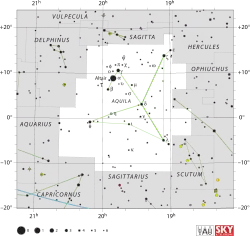
| |
| Observation data Epoch J2000 Equinox J2000 | |
|---|---|
| Constellation | Aquila |
| Right ascension | 19h 42m 34.00828s[1] |
| Declination | +11° 49′ 35.7023″[1] |
| Apparent magnitude (V) | 5.292[2] (5.80/6.68)[3] |
| Characteristics | |
| Spectral type | G2 Ib-II + B5 V[3] |
| U−B color index | +0.01[4] |
| B−V color index | +0.56[4] |
| Astrometry | |
| Radial velocity (Rv) | −19.2[2] km/s |
| Proper motion (μ) | RA: 1.75[1] mas/yr Dec.: −10.11[1] mas/yr |
| Parallax (π) | 3.82 ± 0.51 mas[1] |
| Distance | approx. 900 ly (approx. 260 pc) |
| Absolute magnitude (MV) | −1.53 (−2.1 + −1)[5] |
| Details | |
| Luminosity | 420[6] L☉ |
| Temperature | 5,545[6] K |
| Rotational velocity (v sin i) | 3.6[7] km/s |
| Other designations | |
| Database references | |
| SIMBAD | data |
Chi Aquilae (χ Aql, χ Aquilae) is the Bayer designation for a binary star[3] in the equatorial constellation of Aquila, the eagle. This system is bright enough to be seen with the naked eye at a combined visual magnitude of +5.29.[2] Based upon parallax measurements made during the Hipparcos mission, Chi Aquilae is at a distance of approximately 900 light-years (280 parsecs) from Earth.[1]
The two components of χ Aquilae can be separated in the spectrum and their relative brightness has been measured, but their other properties are uncertain. The cool component is a G2 bright giant or supergiant and is visually brighter than the hot component, so it is treated as the primary. The hot component is a late B- or A-type star, presumed to be a main-sequence star.[5][3]
The observed spectrum of the primary star is G2 Ib, a yellow supergiant. It is calculated to have an absolute magnitude of −2.1. The secondary is observed to have a spectral type of B5.5 and is expected to be a main-sequence star with an absolute magnitude of −1. However, the brightness difference between a G2 supergiant and a B5.5 dwarf is expected to be larger. It is unclear whether the primary is not a supergiant or the secondary is brighter than a main-sequence star.[5]
As of 2004, the secondary is located at an angular separation of 0.418 arcseconds along a position angle of 76.7° from the primary.[8] The separation and position angle are both decreasing.[9]
References
- 1 2 3 4 5 6 van Leeuwen, F. (November 2007), "Validation of the new Hipparcos reduction", Astronomy and Astrophysics, 474 (2): 653–664, arXiv:0708.1752, Bibcode:2007A&A...474..653V, doi:10.1051/0004-6361:20078357, S2CID 18759600.
- 1 2 3 Nordström, B.; et al. (May 2004), "The Geneva-Copenhagen survey of the Solar neighbourhood. Ages, metallicities, and kinematic properties of ˜14 000 F and G dwarfs", Astronomy and Astrophysics, 418 (3): 989–1019, arXiv:astro-ph/0405198, Bibcode:2004A&A...418..989N, doi:10.1051/0004-6361:20035959, S2CID 11027621.
- 1 2 3 4 Eggleton, P. P.; Tokovinin, A. A. (September 2008), "A catalogue of multiplicity among bright stellar systems", Monthly Notices of the Royal Astronomical Society, 389 (2): 869–879, arXiv:0806.2878, Bibcode:2008MNRAS.389..869E, doi:10.1111/j.1365-2966.2008.13596.x, S2CID 14878976.
- 1 2 Oja, T. (1991). "UBV photometry of stars whose positions are accurately known. VI". Astronomy and Astrophysics Supplement Series. 89: 415. Bibcode:1991A&AS...89..415O.
- 1 2 3 Ginestet, N.; Carquillat, J. M. (2002). "Spectral Classification of the Hot Components of a Large Sample of Stars with Composite Spectra, and Implication for the Absolute Magnitudes of the Cool Supergiant Components". The Astrophysical Journal Supplement Series. 143 (2): 513. Bibcode:2002ApJS..143..513G. doi:10.1086/342942.
- 1 2 McDonald, I.; Zijlstra, A. A.; Boyer, M. L. (2012). "Fundamental parameters and infrared excesses of Hipparcos stars". Monthly Notices of the Royal Astronomical Society. 427 (1): 343–357. arXiv:1208.2037. Bibcode:2012MNRAS.427..343M. doi:10.1111/j.1365-2966.2012.21873.x. S2CID 118665352.
- ↑ Ammler-von Eiff, Matthias; Reiners, Ansgar (June 2012), "New measurements of rotation and differential rotation in A-F stars: are there two populations of differentially rotating stars?", Astronomy & Astrophysics, 542: A116, arXiv:1204.2459, Bibcode:2012A&A...542A.116A, doi:10.1051/0004-6361/201118724, S2CID 53666672.
- ↑ Scardia, M.; et al. (April 2006), "Speckle observations with PISCO in Merate - II. Astrometric measurements of visual binaries in 2004", Monthly Notices of the Royal Astronomical Society, 367 (3): 1170–1180, Bibcode:2006MNRAS.367.1170S, doi:10.1111/j.1365-2966.2006.10035.x.
- ↑ Hartkopf, William I.; Mason, Brian D.; McAlister, Harold A.; Roberts, Lewis C.; Turner, Nils H.; Ten Brummelaar, Theo A.; Prieto, Cristina M.; Ling, Josefina F.; Franz, Otto G. (2000). "ICCD Speckle Observations of Binary Stars. XXIII. Measurements during 1982-1997 from Six Telescopes, with 14 New Orbits". The Astronomical Journal. 119 (6): 3084. Bibcode:2000AJ....119.3084H. doi:10.1086/301402.